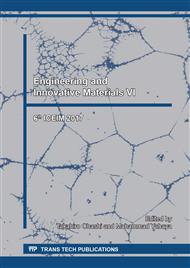p.196
p.201
p.208
p.213
p.218
p.225
p.230
p.235
p.241
Out-of-Plane Deformation Measurement of Soft Solid Using a Stereo Camera System
Abstract:
Soft solid undergoes large deformation under external loading. In order to understand the mechanical characteristics of soft solid, a quantitative evaluation of the deformation behavior is necessary. In the previous study, a strain distribution on the surface of soft solid during an indentation (penetration) test was obtained by evaluating the deformation behavior using isoparametric finite element. However, three-dimensional deformations including out-of-plane deformation was neglected. In this study, the deformation behavior of the soft solid was analyzed using a stereo camera system and binocular disparity method. The out-of-plane deformation of the soft solid was then reconstructed three-dimensionally. Analysis result showed that this study was able to reconstruct the out-of-plane deformation in the area below the indenter. In addition, the displacements of specific points located on the deformed surface could also be estimated. Under the indentation loading condition, the out-of-plane displacements of points in the area below the indenter were estimated to be between 5.9 and 9.9 mm. However, the accuracy of the estimation should be validated by other measurement techniques in the future.
Info:
Periodical:
Pages:
218-222
Citation:
Online since:
January 2018
Authors:
Price:
Сopyright:
© 2018 Trans Tech Publications Ltd. All Rights Reserved
Share:
Citation:


